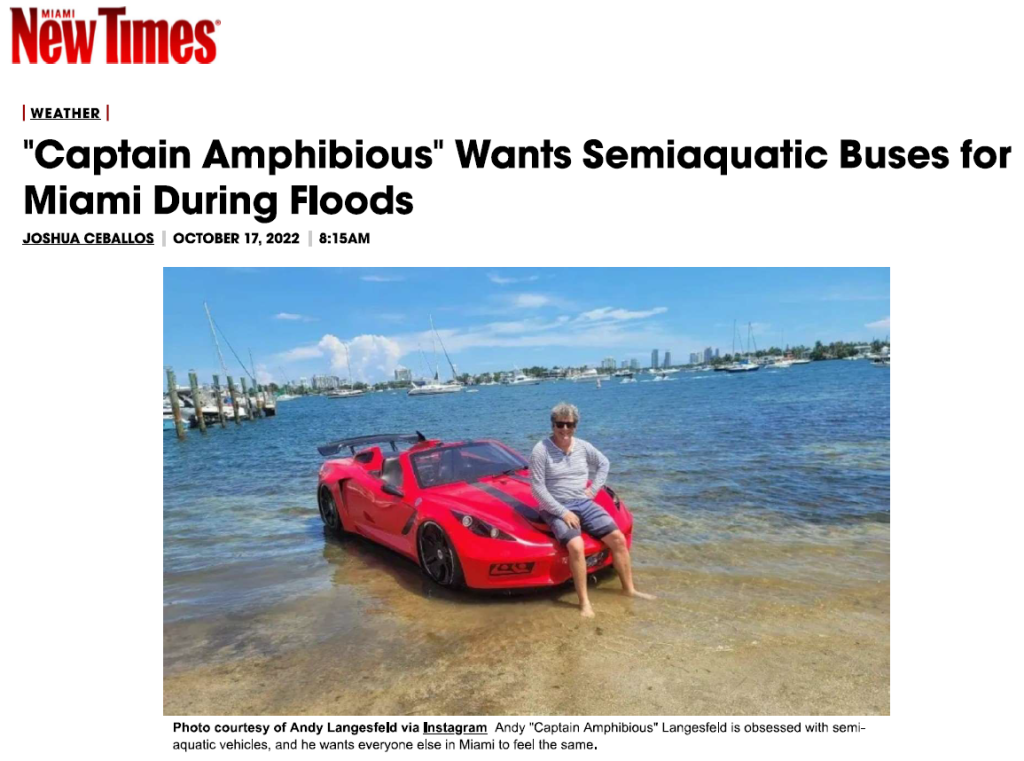-
11.01.2022
Miami New Times Article RE Nouvoyage 22-10-10

Andy Langesfeld is obsessed with amphibious transportation. Cars that sail on water, ships with wheels — anything that can move between land and sea floats his boat. His kids ask him to park blocks away when he drops them off at school, so their friends don’t laugh at his boat-car hybrid.
A former captain of Miami Pirate Duck Tours, Langesfeld has been driving off the road and into Miami’s waterways for over two decades.
Since at least 2016, the semiaquatic seaman has lobbied his local government to bring his passion to the public by creating a fleet of duck trolleys for the City of Miami.
Though his plans have so far treaded water, Langesfeld is still trying to make his amphibious dream a reality six years later. After watching the intense flooding from Hurricane Ian in southwest Florida and from king tides in Miami, he says his ideas don’t look so outlandish anymore. “I’m based in Allapattah, which is notorious for flooding. Three months ago the water was up to my door, so I took my amphibious car out, and my neighbors whose cars were ruined asked me to talk to our city commissioner to tell him we need more of these vehicles,” Langesfeld tells New Times.
For the past few months, Langesfeld has reached out to City of Miami staff while working with outside partners in Boston to create an aquatic bus service that can serve Miami in the event of severe flooding. His idea is to create an “amphibious evolution” for transportation and base it in Miami, ground zero for sea level rise.
“The climate is changing on us, and we need to incorporate an amphibious evolution if we want to be able to survive,” Langesfeld explains. “The buses could go in and out of bodies of water to avoid traffic gridlock. When there’s emergencies, I can rescue people from places that are unreachable because of flooding.”
While Langesfeld has the experience and local know-how, his partners in Boston have the design.
Kevin Neprud, owner and chief technical officer at luxury design company Nouvoyage LLC, patented a design for an amphibious vehicle platform back in 2012. He tells New Times his company has used his designs for several military contracts as well as an amphibious limousine, and they’re in the process of creating a bus design for Langesfeld’s vision of semiaquatic public transit.
“Our vehicles can carry between 40 and 48 people, and can also carry two crewmembers. The footprint is similar to urban buses running downtown now, and reach speeds of 25 to 28 knots (28 to 32 mph),” Neprud says.
Neprud explains that the bus design will be high-end and sleek to fit with the city’s aspirations to be a new tech hub. He says they will be hybrid vehicles that can run fully on electricity in the water and will have the ability to push and pull debris during cleanups.
The pair have already engaged with investors and plan to build a facility in Miami that can build and maintain their waterborne buses, making it a fully local operation.
“This is the time. The tech is there, the urgency is here,” Langesfeld says.


